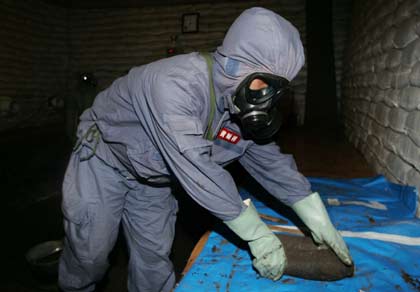Experts from China and Japan concluded on Monday a six-day joint excavation
of abandoned wartime chemical weapons in Ning'an city, Northeast China's
Heilongjiang Province.

Huang Shunxiang, digs out a bomb at an
excavation site of World War Two chemical weapons abandoned by Japan, in
Ning'an, China's Heilongjiang province, July 5, 2006. The joint
Chinese-Japanese team was preparing Wednesday to excavate abandoned
Japanese poison gas bombs from World War II that were buried near a school
after a factory received them as scrap metal.
[Reuters] |
A total of 689 shells and bombs were unearthed, of which 210 were confirmed
to be Japanese chemical weapons abandoned after World War II.
The identified weapons have been confirmed to be filled with mustard gas,
lewisite, phosgene and other toxins.
The weapons had been sealed and placed in temporary storage, awaiting final
destruction, according to the office in charge of abandoned weapons at China's
Foreign Ministry
Chinese official statistics show Japan abandoned at least 2 million tons of
chemical weapons at about 40 sites in 15 provinces at the end of World War II,
most of them in the three northeast provinces of Heilongjiang, Jilin and
Liaoning.
In the past nine years, China and Japan have worked together to investigate,
excavate, retrieve and pack the dumped weapons.
So far 37,499 chemical weapons and 200 tons of contaminated items have been
collected, but none have been destroyed.
"We are rather dissatisfied with Japan's slow pace of disposal, " said Liu
Yiren, director of the Japanese abandoned chemical weapons disposal office under
China's Foreign Ministry.
Liu stressed that the weapons, some still lethal or toxic after decades,
remained a threat nationwide, noting that leakages involving injury or death
have occurred.
One person died and 43 were injured in Qiqihar, Heilongjiang, in one such
incident last August. More than 50 bombs, including chemical weapons, were found
last month in a village near the same city.
More than 2,000 Chinese have fallen victim to Japan's abandoned chemical
weapons, killed by leading toxic gas while working at construction sites or on
other occasions, according to China's Foreign Ministry.
"The facts have proved again we have come to a situation where no more delays
can be tolerated," Liu said.
China and Japan have agreed to build a disposal facility for the destruction
of retrieved chemical weapons in Ha'erba Ridge of Dunhua City, Jilin Province,
neighboring Heilongjiang, where 670,000 chemical weapons have been confirmed
dumped by Japanese troops.
So far Japan has not disclosed any detailed information about where they
abandoned or buried their weapons, making it difficult for China to trace and
remove them.
The lack of information has also led to incidents.
China and Japan joined the United Nations Chemical Weapons Convention in
1997. Two years later, they signed a memorandum, in which Japan admitted that it
had abandoned a large amount of chemical weapons in China at the end of World
War II.
Under the memorandum, Japan is obliged to remove the weapons by April 2007
and provide all necessary funds, equipment and personnel for their retrieval and
destruction.
However, the Japanese government has asked for an extension of the disposal
deadline to April 2012.
"Judging from Japan's current pace of weapons disposal, we can't be too
optimistic about complete destruction by 2012," Liu said.
At the request of the Chinese government, Japan sent more than 20 experts
Wednesday to the Ning'an site.